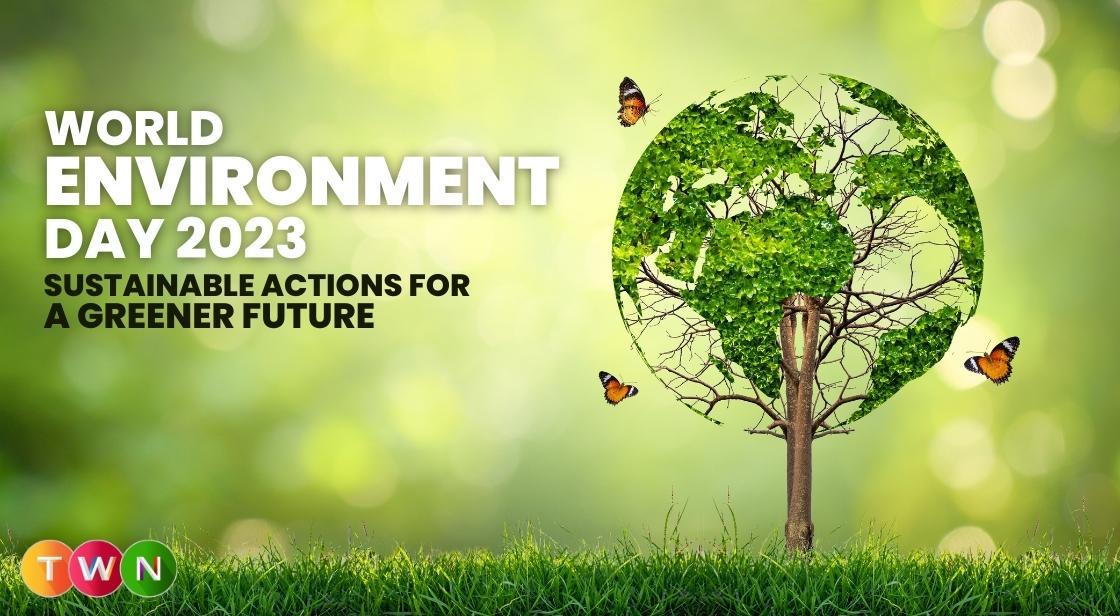World Environment Day 2023: Sustainable Actions for a Greener Future

Blog Post
World Environment Day is celebrated on June 5 every year. The day advocates the causes of the environment and is a call to action for everyone to do their part to protect our planet. The theme for World Environment Day 2023 is "Beat Plastic Pollution."
This year, we need to focus on finding solutions to the plastic pollution crisis. We can all make a difference by reducing our use of single-use plastics, recycling, and composting.
World Environment Day 2023 is a highly anticipated global event that serves as a powerful platform for individuals, communities, and organizations to come together and champion sustainable actions for a greener future.
This significant celebration takes place on June 5th each year and aims to raise awareness about pressing environmental challenges while encouraging collective efforts to address them.
With a strong emphasis on promoting environmental consciousness and fostering positive change, World Environment Day 2023 seeks to inspire people from all walks of life to take tangible and meaningful steps towards building a more sustainable and eco-conscious world.
By mobilizing individuals and communities across the globe, this event plays a pivotal role in driving transformative action and creating a global movement towards environmental preservation and stewardship.
It is a time to reflect on our individual and collective impact on the planet, embrace sustainable practices, and explore innovative solutions that can contribute to a greener and more resilient future for generations to come.
World Environment Day, celebrated on June 5th every year, is a significant event that encourages awareness and action for the protection of our environment. It serves as a platform to promote positive environmental initiatives, raise public awareness, and advocate for sustainable practices. In 2023, World Environment Day takes on even greater importance as the world faces pressing environmental issues such as climate change, pollution, deforestation, and loss of biodiversity.
This article explores the history, theme, and significance of World Environment Day 2023, highlighting some of the best green initiatives from around the world.
History of World Environment Day
World Environment Day has a rich history that dates back to its establishment by the United Nations in 1972. It was created during the United Nations Conference on the Human Environment, held in Stockholm, Sweden. The conference marked a pivotal moment in global environmental governance and recognized the urgent need to address pressing environmental challenges.
The first World Environment Day was celebrated on June 5th, 1974, and since then, it has been observed annually as a global day of action for the environment. Each year, World Environment Day focuses on a specific theme that highlights a pressing environmental issue and provides a platform for raising awareness and driving change.
Over the years, World Environment Day has evolved into a global movement that engages individuals, communities, governments, and organizations from around the world. It serves as an opportunity to promote environmental awareness, encourage sustainable practices, and advocate for policy changes to protect and preserve our natural resources.
The event has witnessed the participation of various stakeholders, including governments, non-governmental organizations, schools, businesses, and citizens, who come together to organize activities such as tree planting, clean-up campaigns, awareness campaigns, and policy discussions. These initiatives aim to inspire and empower individuals to make a positive impact on the environment.
World Environment Day has played a crucial role in catalyzing global action on environmental issues. It has helped drive important conversations and policy changes, leading to the adoption of international agreements and initiatives aimed at addressing pressing environmental challenges such as climate change, biodiversity loss, pollution, and sustainable development.
The history of World Environment Day demonstrates the ongoing commitment and collective efforts of the global community to safeguard the environment and create a sustainable future. It serves as a reminder that individual actions, no matter how small, can contribute to significant positive change when combined with collective efforts.
Theme of World Environment Day 2023
The theme of World Environment Day 2023 is "Beat Plastic Pollution." This theme highlights the need to take action to reduce plastic pollution. Plastic pollution is a global problem that is harming our planet. We need to work together to find solutions to this problem.
Here are some of the things we can do to beat plastic pollution:
-
Reduce our use of single-use plastics. Single-use plastics are items that are used once and then thrown away. These items include things like plastic bags, straws, and water bottles. When we reduce our use of single-use plastics, we are helping to reduce plastic pollution.
-
Recycle. Recycling helps to keep plastic out of landfills and oceans. When we recycle, we are helping to create new products from recycled materials.
-
Compost. Composting is a great way to reduce food waste and help to create nutrient-rich soil. When we compost, we are helping to reduce the amount of organic waste that goes to landfills.
We can also support businesses and organizations that are working to reduce plastic pollution. By working together, we can create a more sustainable future for our planet.
Significance of World Environment Day
World Environment Day holds immense significance in raising global awareness and mobilizing actions for environmental protection. Here are some key points highlighting the significance of World Environment Day:
-
Global Platform for Environmental Action: World Environment Day provides a global platform for governments, organizations, communities, and individuals to come together and take action on pressing environmental issues. It serves as a catalyst for positive change and encourages collaboration across borders to address common environmental challenges.
-
Raising Awareness: The day plays a vital role in raising awareness about critical environmental issues and their impact on ecosystems, biodiversity, and human well-being. It educates and informs people about the importance of environmental conservation, sustainable practices, and the need for urgent action to mitigate environmental degradation.
-
Advocacy for Policy Change: World Environment Day serves as an opportunity for advocacy and policy dialogue at local, national, and international levels. It encourages governments and policymakers to assess environmental policies, strengthen legislation, and adopt sustainable practices to protect natural resources and combat climate change.
-
Encouraging Individual Action: The day motivates individuals to take responsibility for their actions and make sustainable choices in their daily lives. It inspires behavioral changes such as reducing waste, conserving energy and water, adopting eco-friendly practices, and supporting sustainable products and initiatives.
-
Mobilizing Community Engagement: World Environment Day promotes community engagement and mobilization by organizing various activities such as tree planting campaigns, clean-up drives, environmental awareness campaigns, and educational programs. These initiatives empower communities to actively participate in environmental conservation and create a sense of collective responsibility.
-
Highlighting Urgent Environmental Issues: Each year, World Environment Day focuses on a specific environmental theme, shedding light on pressing issues that require immediate attention. By highlighting these issues, the day prompts discussions, research, and action-oriented initiatives to find innovative solutions and drive positive change.
-
Fostering International Cooperation: World Environment Day encourages international cooperation and collaboration among countries, organizations, and stakeholders. It provides a platform for sharing best practices, knowledge, and resources to tackle environmental challenges collectively. This cooperation strengthens global environmental governance and promotes sustainable development.
World Environment Day holds immense significance in promoting environmental awareness, advocacy, and collective action. By raising global consciousness about environmental issues, it plays a crucial role in fostering sustainable practices, driving policy change, and mobilizing individuals and communities towards a greener and more sustainable future.
The Urgency of Sustainable Actions
The current state of our planet demands immediate action to combat pressing environmental issues. From climate change to pollution, deforestation, and biodiversity loss, the need for sustainable actions has never been more critical. This section explores the urgency and importance of taking steps towards a greener future.
Addressing Climate Change: Innovations and Solutions
Climate change is one of the most significant challenges of our time. This section delves into innovative solutions and sustainable practices that help mitigate climate change and reduce greenhouse gas emissions. From renewable energy to energy-efficient technologies, various initiatives are making a positive impact.
Combatting Pollution: Best Practices and Success Stories
Pollution poses a severe threat to our environment and human health. This section highlights successful pollution control measures and best practices implemented around the world. From air and water pollution to waste management and plastic reduction, effective strategies are showcased.
Preserving Biodiversity: Conservation Efforts around the Globe
Biodiversity is essential for the health and balance of our ecosystems. This section focuses on the conservation efforts taking place worldwide to protect and preserve biodiversity. From the establishment of protected areas and wildlife sanctuaries to the conservation of endangered species and habitat restoration, numerous initiatives are making a positive impact on biodiversity conservation.
Sustainable Agriculture: Feeding the World Without Harming the Environment
The agricultural sector plays a vital role in global food production, but it also has a significant environmental footprint. This section explores sustainable agricultural practices that promote food security while minimizing environmental degradation. From organic farming and permaculture to precision agriculture and agroforestry, innovative approaches are reshaping the agricultural landscape.
Green Initiatives: Inspiring Examples of Environmental Stewardship
Numerous green initiatives and projects are leading the way in environmental stewardship. This section highlights inspiring examples from around the world, showcasing innovative solutions and sustainable practices. From eco-friendly architecture and renewable energy projects to waste management and sustainable transportation, these initiatives demonstrate the power of individual and collective action.
Empowering Communities: Grassroots Movements for Change
Meaningful change often starts at the grassroots level, driven by individuals and local communities. This section focuses on grassroots movements that have played a crucial role in advocating for sustainable actions and influencing policy changes. Through community engagement, education, and mobilization, these movements are shaping a greener future.
Promoting Sustainable Consumption and Production
The way we consume and produce goods has a significant impact on the environment. This section explores the concept of sustainable consumption and production, highlighting initiatives that promote responsible consumption patterns, circular economy practices, and reduced waste generation. From sustainable fashion to eco-friendly packaging, innovative approaches are reshaping consumption habits.
Education and Awareness: Empowering the Next Generation of Environmental Stewards
Education and awareness are essential in driving sustainable actions. This section emphasizes the importance of environmental education, both formal and informal, in shaping the mindset and behaviors of individuals. It highlights initiatives that focus on raising awareness, fostering environmental literacy, and empowering the next generation to become environmental stewards.
Collaborative Efforts: International Cooperation for a Greener Future
Environmental challenges are global in nature and require international cooperation. This section explores collaborative efforts between countries, organizations, and stakeholders to address pressing environmental issues. From international agreements and conventions to joint research projects and knowledge-sharing platforms, these efforts showcase the power of collaboration in building a greener future.
Also Read: Renewable Energy: A Booming Gateway To Sustainability
Organization and Business promotion sustainable practicess
Here are organizations that raise awareness, develop technologies, and promote reusable products to combat plastic pollution:
Organizations That Raise Awareness
1. 5 Gyres Institute:
This organization focuses on researching and raising awareness about plastic pollution in the world's oceans. They conduct scientific expeditions and provide education and outreach programs to inspire individuals and communities to take action against plastic pollution.
5 Gyres Institute is a non-profit organization dedicated to researching and raising awareness about plastic pollution in the world's oceans. They conduct scientific expeditions to study the presence and impact of plastic pollution in various marine environments, including oceans, lakes, and rivers. By collecting data and analyzing samples, they contribute to a deeper understanding of the extent and consequences of plastic pollution.
The organization also plays a crucial role in education and outreach. They develop educational resources, organize workshops, and collaborate with schools and communities to raise awareness about the harmful effects of plastic pollution and promote sustainable solutions. Through their programs, they empower individuals to make informed choices and take action to reduce plastic waste in their daily lives.
Additionally, 5 Gyres Institute actively engages with policymakers, industry leaders, and the general public to advocate for policy changes and promote innovative solutions to plastic pollution. They aim to inspire a global movement that drives systemic change and supports the transition to a more sustainable and plastic-free future.
By conducting research, providing education and outreach, and advocating for change, 5 Gyres Institute contributes to the collective effort of addressing plastic pollution and protecting our oceans. Their work highlights the urgency of the issue and encourages individuals, communities, and policymakers to take meaningful action in preserving our marine ecosystems.
2. Ellen MacArthur Foundation
The Ellen MacArthur Foundation is a global non-profit organization that works to accelerate the transition to a circular economy. The foundation was founded in 2010 by Dame Ellen MacArthur, a former professional sailor who became an advocate for sustainable and regenerative economic systems. Here are some key initiatives and contributions of the Ellen MacArthur Foundation:
-
Circular Economy Framework: The foundation promotes the concept of a circular economy, which aims to decouple economic growth from resource consumption and environmental degradation. They have developed a comprehensive framework that outlines the principles and strategies for implementing a circular economy across various sectors.
-
Research and Knowledge Sharing: The Ellen MacArthur Foundation conducts extensive research and analysis on topics related to the circular economy. They publish reports, case studies, and insights to disseminate knowledge and raise awareness about the benefits and opportunities of adopting circular economy principles.
-
Global Collaborations: The foundation collaborates with governments, businesses, academic institutions, and NGOs worldwide to drive systemic change towards a circular economy. They facilitate cross-sector partnerships and initiatives to share expertise, foster innovation, and develop practical solutions.
-
Circular Design and Innovation: The Ellen MacArthur Foundation promotes circular design principles to ensure that products, services, and systems are designed with longevity, recyclability, and resource efficiency in mind. They work with designers, engineers, and innovators to develop innovative solutions that eliminate waste and promote circularity.
-
Circular Economy Education: Recognizing the importance of education in driving a circular economy transition, the foundation supports educational initiatives and programs. They work with schools, universities, and educational institutions to integrate circular economy concepts into curricula and promote sustainable thinking among future generations.
-
Circular Economy in Fashion and Plastics: The Ellen MacArthur Foundation has launched specific initiatives focused on two key sectors: fashion and plastics. Their programs, such as the Circular Fibres Initiative and the New Plastics Economy, aim to transform these industries by rethinking production methods, improving material recycling, and reducing waste.
-
Global Commitments and Partnerships: The foundation actively engages with businesses and governments through commitments and partnerships. For example, they initiated the Global Commitment, a collaboration with leading companies to eliminate plastic waste and create a circular economy for plastics. They also work closely with the United Nations Environment Programme (UNEP) to advance the circular economy agenda.
3. Plastic Bank:
Plastic Bank aims to reduce plastic pollution by incentivizing the collection and recycling of plastic waste. They establish collection centers in developing countries where individuals can exchange plastic waste for money, goods, or services, promoting economic empowerment and environmental sustainability.
Organizations That Develop Technologies
4. Seabin Project:
The Seabin is an innovative device designed to collect floating debris, including plastics, from marinas, harbors, and other water bodies. It operates using a water pump that creates a flow to draw in and capture floating waste, helping to prevent it from entering the ocean.
5. The Plastic Tide:
This organization uses drones and artificial intelligence to identify and map plastic pollution on beaches. By collecting data on the scale and distribution of plastic waste, they aim to inform and guide clean-up efforts and raise awareness about the extent of the problem.
Organizations That Collect and Recycle
6. Precious Plastic:
Precious Plastic is an open-source platform that provides instructions and resources for individuals and communities to set up their own plastic recycling workshops. They offer designs for machines that can shred, melt, and mold plastic waste into new products, promoting local recycling initiatives.
7. Plastic Oceans International:
This organization focuses on education, advocacy, and research to address the issue of plastic pollution. They produce films, documentaries, and educational resources to raise awareness about the impact of plastic on marine ecosystems and inspire global change.
Organizations That Sell Reusable Products
8. FinalStraw:
FinalStraw offers reusable and collapsible metal straws as an eco-friendly alternative to single-use plastic straws. They aim to reduce plastic waste by providing individuals with a convenient and sustainable option for enjoying beverages on the go.
9. KeepCup:
KeepCup produces reusable coffee cups made from materials such as glass and BPA-free plastic. Their cups are designed to be durable, stylish, and environmentally friendly, encouraging people to switch from disposable coffee cups to reusable alternatives.
By supporting and engaging with these organizations, individuals can contribute to the global effort to combat plastic pollution and promote sustainable practices. Through awareness, technology, recycling, and the use of reusable products, we can all make a significant impact in creating a cleaner and healthier environment.
Conclusion: Embracing Sustainable Actions for a Greener Future
World Environment Day 2023 serves as a reminder of the urgency to address environmental challenges and embrace sustainable actions. From climate change to pollution, biodiversity loss, and unsustainable practices, the need for a greener future is paramount.
By adopting sustainable practices in our daily lives, supporting green initiatives, and advocating for policy changes, we can collectively make a positive impact on our planet. World Environment Day reminds us that each action, no matter how small, contributes to a more sustainable and eco-conscious world. Let us join hands and work together towards a greener future for generations to come.
You May Like
EDITOR’S CHOICE












